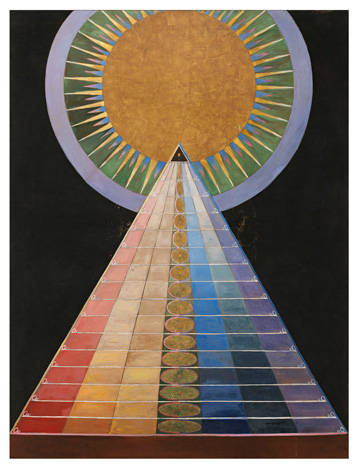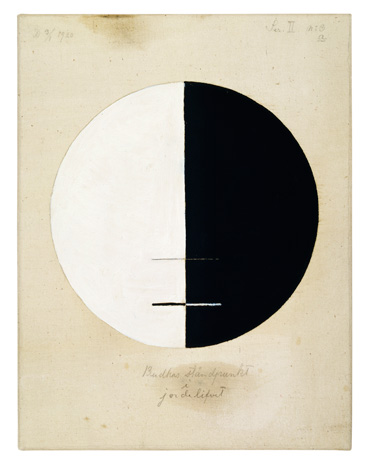HILMA AF KLINT: A PIONEER OF ABSTRACTION
In 1908 a major change occurred to her. She met the founder of anthroposophy, Rudolf Steiner. Anthroposophy is a philosophy that embraces an instinctive worldview that transcends the material world. It may seem mystical at times, but it has had a big impact on people regarding education and the arts. Her interaction with such thinking made her expression even more astute, and the abstractness of her works was heightened.

Hilma af Klint, Altarpiece No. 1, 1915 © Stiftelsen Hilma af Klints Verk, Photo: Moderna Museet / Albin Dahlström
For example, “Altarpieces” created in 1915 included circles and triangles drawn geometrically. The circle extends radially as if signifying brightness, and the triangle painted using seven different colors becomes lighter as it grows towards its apex and overlaps with the circle. The circle as a star, the color black as the universe, and the triangle as light — her work seems to explain the role of humans in the world and the universe.

Hilma af Klint, Buddhas Standpoint in the Earthly Life No. 3, 1920 © Stiftelsen Hilma af Klints Verk, Photo: Moderna Museet / Albin Dahlström
Her abstract paintings convey a powerful internal world. As their role is to try to get people to feel what cannot be seen, one would even say they are enlightening. For example, the word “EVOLUTION” appears on the surface of one painting. This expresses our need for evolution. We can understand the role of a cross on a canvas as clearly as its role in religion. These words and symbols with straightforward meanings do not hold secondary meanings, but directly express what the artist is trying to convey. Her ideas, which attempted to communicate that which cannot be seen as well as the spiritual, are lucid. Therefore, the directness of her form of expression continues to speak to us today.
Read more ...




